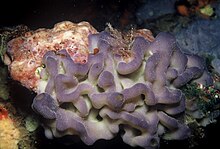Taxonomy
Homoscleromorpha is phylogenetically well separated from Demospongiae. [4] Therefore, it has been recognized as the fourth class of sponges. [5] [6]
It has been suggested that Homoscleromorpha are more closely related to eumetazoans than to the other sponge groups, rendering sponges paraphyletic. [7] This view has not been supported by later work using larger datasets and new techniques for phylogenetic inference, which tend to support sponges as monophyletic, with Homoscleromorpha grouping together with Calcarea. [8] [9]
On the basis of molecular and morphological evidence, the two families Plakinidae and Oscarellidae have been reinstated. [5]
There are 136 species in this group divided into 10 genera. [6]
The spiculate genera in this group are Aspiculophora , Aspiculortis , Corticium , Placinolopha , Plakina , Plakinasterella , Plakortis and Tetralophophora .
The aspiculate species are the genera Oscarella and Pseudocorticium .
This page is based on this
Wikipedia article Text is available under the
CC BY-SA 4.0 license; additional terms may apply.
Images, videos and audio are available under their respective licenses.

